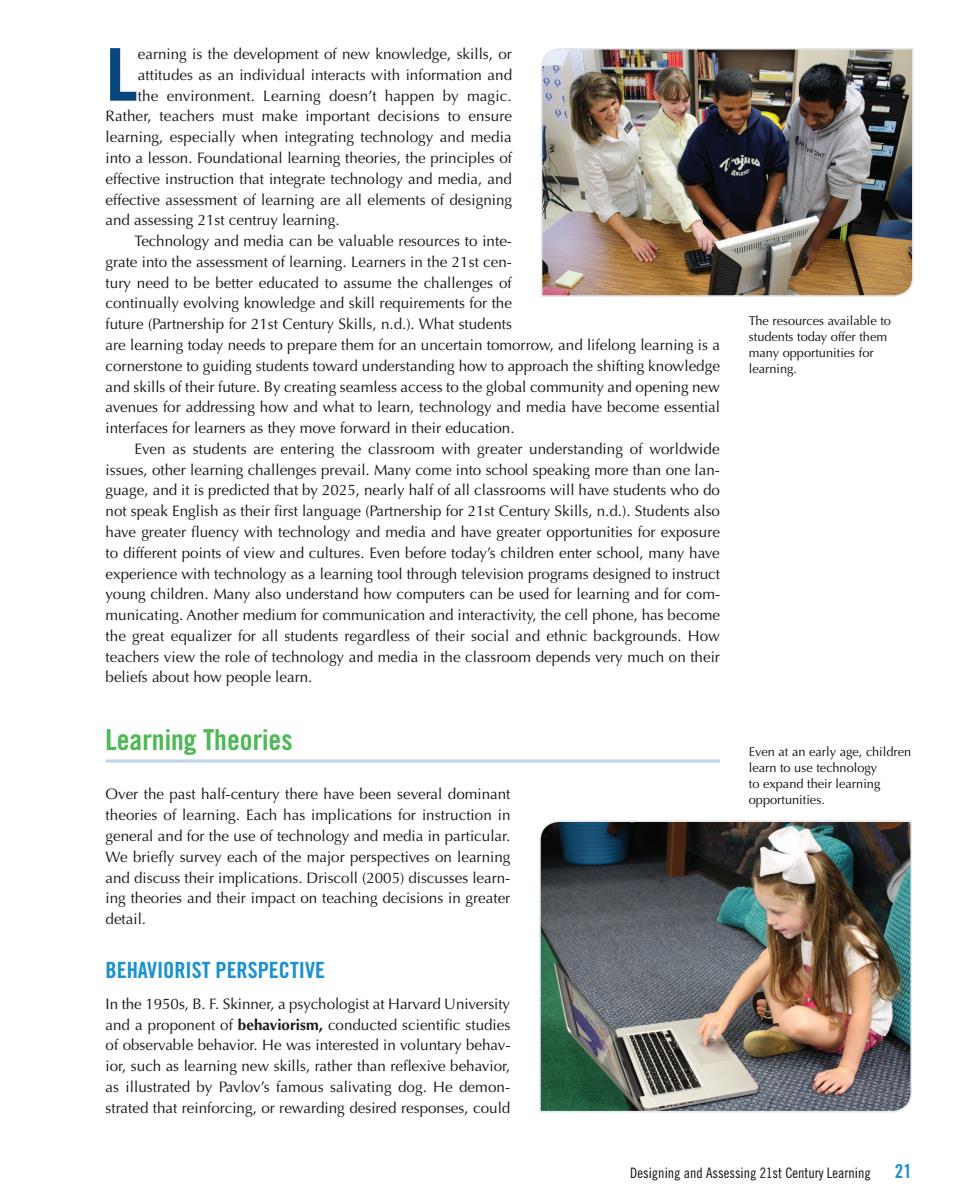正在加载图片...

earning is the development of new knowledge,skills.or attitudes as an individual interacts with information and the environment.Learning doesn't happen by magic Rather.teachers must make important decisions to en leaming especially when integrating technology and media nto eaing theories,th ction that integ principles of nd valuable s to inte grate intoth ledge Skills,n The resource available t are learing today needs sto prepare ther n tomorrow,and lifelong learning is a students today offer then stone to guiding stu dents toward under ow to e shifting knowledge of th By creating sear avenues for addre v and what to learn nterfaces for learners as they move forward in their education Even as students are entering the classroom with greater understanding of worldwide issues,other learning challenges prevail.Many come into school speaking more than one lan- guage,and it is predicted that by 2025,nearly half of all classrooms will have students who do not speak English as their first language (Partnership for 21st Century Skills,n.d.).Students also have greater fluency with technology and media and have greater opportunities for exposure to different points of view and cultures.Even before today's children enter school,many have experience with technology as a learning tool through television programs designed to instruct young children.Many also understand how computers can be used for learning and for com- municating.Another medium for communication and interactivity,the cell phone,has become the great equalizer for all students regardless of their social and ethnic backgrounds.How teachers view the role of technology and media in the classroom depends very much on their beliefs about how people learn. Learning Theories Even at an earl Ovet the past haif cen has iplications for instruction in opportunities. or the us dia in particular riefly survey each othemaiorpe ctives on learning and discuss the implications.Drisco (20 discusses learn ing theories and their impact on teaching decisions in greater detail. BEHAVIORIST PERSPECTIVE In the 1950s,B.F.Skinner,a psychologist at Harvard University and a proponent of behaviorism,conducted scientific studies of observable behavior.He was interested in voluntary behav- ior.such as learning new skills.rather than reflexive behavion as illustrated by Pavlov's famous salivating dog.He demon- strated that reinforcing,or rewarding desired responses,could Designing and Assessing 21st Century Leaming 21 Designing and Assessing 21st Century Learning 21 L earning is the development of new knowledge, skills, or attitudes as an individual interacts with information and the environment. Learning doesn’t happen by magic. Rather, teachers must make important decisions to ensure learning, especially when integrating technology and media into a lesson. Foundational learning theories, the principles of effective instruction that integrate technology and media, and effective assessment of learning are all elements of designing and assessing 21st centruy learning. Technology and media can be valuable resources to integrate into the assessment of learning. Learners in the 21st century need to be better educated to assume the challenges of continually evolving knowledge and skill requirements for the future (Partnership for 21st Century Skills, n.d.). What students are learning today needs to prepare them for an uncertain tomorrow, and lifelong learning is a cornerstone to guiding students toward understanding how to approach the shifting knowledge and skills of their future. By creating seamless access to the global community and opening new avenues for addressing how and what to learn, technology and media have become essential interfaces for learners as they move forward in their education. Even as students are entering the classroom with greater understanding of worldwide issues, other learning challenges prevail. Many come into school speaking more than one language, and it is predicted that by 2025, nearly half of all classrooms will have students who do not speak English as their first language (Partnership for 21st Century Skills, n.d.). Students also have greater fluency with technology and media and have greater opportunities for exposure to different points of view and cultures. Even before today’s children enter school, many have experience with technology as a learning tool through television programs designed to instruct young children. Many also understand how computers can be used for learning and for communicating. Another medium for communication and interactivity, the cell phone, has become the great equalizer for all students regardless of their social and ethnic backgrounds. How teachers view the role of technology and media in the classroom depends very much on their beliefs about how people learn. Learning Theories Over the past half-century there have been several dominant theories of learning. Each has implications for instruction in general and for the use of technology and media in particular. We briefly survey each of the major perspectives on learning and discuss their implications. Driscoll (2005) discusses learning theories and their impact on teaching decisions in greater detail. Behaviorist Perspective In the 1950s, B. F. Skinner, a psychologist at Harvard University and a proponent of behaviorism, conducted scientific studies of observable behavior. He was interested in voluntary behavior, such as learning new skills, rather than reflexive behavior, as illustrated by Pavlov’s famous salivating dog. He demonstrated that reinforcing, or rewarding desired responses, could The resources available to students today offer them many opportunities for learning. Even at an early age, children learn to use technology to expand their learning opportunities. M02_SMAL4150_01_SE_C02.indd 21 2/7/14 8:37 AM